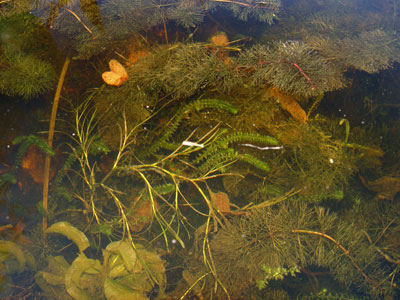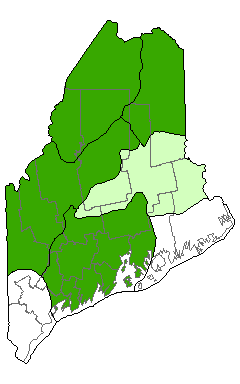DACF Home → Bureaus & Programs → Maine Natural Areas Program → Communities, Plants, and Animals → Natural Community Fact Sheets → Circumneutral Pond
Printer Friendly Fact Sheet - 1.2 MB pdf (Get a free copy of Adobe Acrobat Reader)
Circumneutral Pond
Scientific Name: Circumneutral - Alkaline Water Macrophyte Suite; State Rank: S2

- Community Description
- Soil and Site Characteristics
- Diagnostics
- Similar Types
- Conservation, Wildlife and Management Considerations
- Distribution
- Characteristic Plants
- Associated Rare Plants
- Associated Rare Animals
- Examples on Conservation Lands You Can Visit
Community Description: The variable aquatic vegetation in this community type features floating leaved and submerged plants restricted or preferential to higher pH waters. Indicator species include tapegrass, common waterweed, water stargrass, white water crowfoot, Robbins’ pondweed, alpine pondweed, Vasey’s pondweed, and straight-leaved pondweed. Vegetation cover is usually 25-65%, occasionally higher. This type is broadly defined and heterogeneous; further sampling would be needed to discriminate subtypes. Back to top.
Soil and Site Characteristics: This type occurs in alkaline lakes or ponds (conductivity usually >50 uMHOS/cm), in quiet waters at depths less than two meters. Back to top.
Diagnostics: At least some of the indicator species listed above are present, and water-shield, pipewort, water lobelia, and pickerelweed are virtually absent. Yellow and white water-lilies, if present, are at low cover. Back to top.
Similar Types: This broad type can show similarities to other aquatic types, especially to the Open-water Marsh type. That type has higher cover of yellow and white water-lilies or of bigleaf pondweed, but more sampling of both types is needed to better distinguish them. Back to top.
Conservation, Wildlife and Management Considerations: This aquatic community type is sporadic in Maine, and further work is needed to document its distribution and characteristics. A few examples occur on public lands and private conservation lands; many are in great ponds (>10 acres), which are a public resource. The major threats to this community are water quality degradation from excess nutrients in runoff and the spread of invasive aquatic plants, such as Eurasian water-milfoil and variable water-milfoil.
Alkaline ponds with aquatic vegetation may support many of the same wildlife species found in more acidic aquatic communities such as Water-lily Macrophyte Aquatic Bed or Pickerelweed - Macrophyte Aquatic Bed. It is unclear whether any wildlife species prefer the more alkaline conditions that this community provides. Back to top.
Distribution: Central Maine northward (Laurentian Mixed Forest and New England - Adirondack Forest Provinces); distribution includes upstate New York; otherwise not well matched in other state classification documents. Landscape Pattern: Small Patch. Back to top.


Characteristic Plants: These plants are frequently found in this community type. Those with an asterisk are often diagnostic of this community.
- Herb
- Common waterweed*
- Robbins' pondweed*
- Slender water-milfoil*
- Tapegrass*
- Water-marigold*
- Bryoid
- Chara algae
There are no documented rare animals associated with this natural community.
Examples on Conservation Lands You Can Visit
| Example | County |
|---|---|
| Caswell National Guard Site | Aroostook Co. |
| Number Five Bog Public Lands | Somerset Co. |